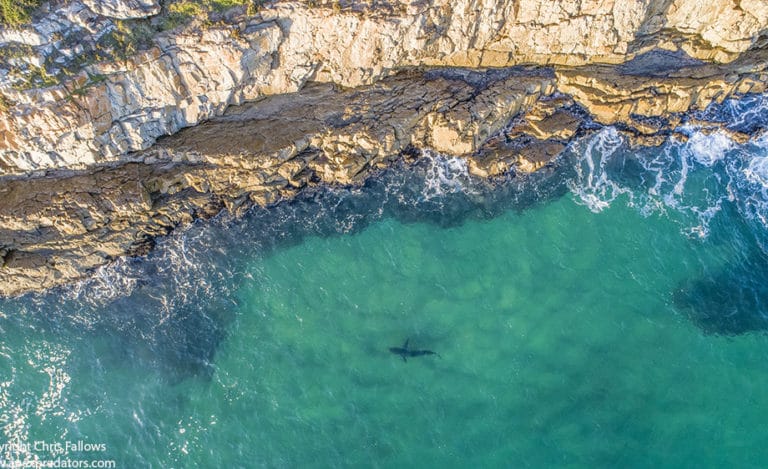Gansbaai, two hours outside of Cape Town is an embayment on the South West coast of the Western Cape. The water temperature varies from 12 – 20 degrees celsius, and the water visibility on average is 6 – 8 meters, increasing up to 12 – 15 meters on a good day and down to 1 – 3 meters on a poor day.
When observing nature there is never a guarantee, each day is different. Up to 18 Great White sharks have been recorded in a single day, whilst the average sightings are 4 – 8 Great White sharks per trip.
In Gansbaai, the shark cage diving operators are permitted to work inshore, unlike the False Bay operators. This allows them to operate throughout the year, weather permitting. The area is visited by Great White sharks of both sexes and various sizes although mostly juveniles. This area has its regulars too, “Slashfin”, has been recorded at the island for 12 years running! Population estimates for Great White sharks in Gansbaai are considerably higher than those obtained for other aggregation areas, being +- 532, supporting claims that South Africa has the largest remaining populations of coastal great white sharks.
Guide to shark tours in Gansbaai
ONE OF DYER ISLAND’S MALES, “SLASHFIN”, HAS BEEN RECORDED AT THE ISLAND FOR 12 YEARS RUNNING!
Although the focus of Guide to shark tours in Gansbaai is cage diving, predations by Great White sharks on Cape Fur seals (Arctocephalus pusillus) have been observed at Dyer Island from July through to August. The Cape Fur seal pup is most vulnerable to the Great White shark, as it is an easy and nutritious meal. After about 7-9 months it is weaned off its mother’s milk, which consists mainly of fats and proteins, and has almost doubled in weight since being born.

The Dyer Island Conservation Trust which was founded in 2006 works to conserve the Marine Big 5 (Great White shark, African penguin, Southern Right whale, Cape Fur seal, and the Common dolphin), as well as the many sea birds in and around the area. The trust conducts valuable research, ongoing conservation, and education. Marine Dynamics of Gansbaai has been instrumental in building a database of thousands of photographs of the Great White dorsal fins seen within the Gansbaai area as part of an identification project.
Little is known about the Great White’s small-scale movements.
More research needs to be conducted which will help answer questions such as why they move to the shallow regions in the summer months. More research is also being done on the way they interact with other species, the population dynamics, and the effect of the sea conditions on great white sharks.
There is a study currently underway in Gansbaai on parasites found on Great White sharks and the effect on their health.
For more details on the trip, Apex Shark Expeditions facilitate, visit Great White shark cage diving in Gansbaai. You might also be interested in some of our other activities such as our Exclusive Whale watching in De Hoop, South Africa.




